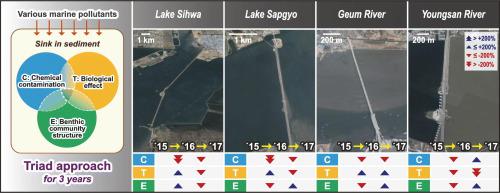Marine Pollution Bulletin ( IF 5.8 ) Pub Date : 2020-09-11 , DOI: 10.1016/j.marpolbul.2020.111592 Aslan Hwanhwi Lee 1 , Junghyun Lee 1 , Junsung Noh 1 , Changkeun Lee 1 , Seongjin Hong 2 , Bong-Oh Kwon 3 , Jae-Jin Kim 4 , Jong Seong Khim 1

|
The environmental DNA (eDNA) metabarcoding was applied to assess benthic ecological health in the west coast of South Korea by investigating a long-term microbial community change (2015–17). The ecological interaction among microorganisms, from phylum to family level, and their associations to environmental variables across the five regions were highlighted. As part of the study, the available chemistry and toxicological data in the regions during the monitoring periods were incorporated into an integrated sediment triad assessment. The bacterial communities were dominated by Proteobacteria (34.2%), Bacteroidetes (13.8%), and Firmicutes (10.8%). Proteobacteria and Bacteroidetes dominated consistently across regions and years, while Firmicutes and Cyanobacteria significantly varied by region and years (p < 0.05). The abundance of this phylum declined over time with the increasing abundance of Cyanobacteria, indicating their independent interactions to certain environmental changes. Planctomycetes and Gemmatimonadetes linked to some contaminants (ΣPAHs and Cu), implying indicator taxa. Overall, eDNA-based microbial community analysis combined with exposures of contaminants and responses of microorganisms is a promising strategy for the assessment of benthic ecological health in contaminated sediments from coastal waters.
中文翻译:

来自韩国西海岸受污染沉积物的微生物群落的长期变化特征:利用eDNA和理化分析进行生态评估。
通过调查长期的微生物群落变化,将环境DNA(eDNA)元条形码用于评估韩国西海岸底栖生态健康(2015-17)。着重强调了五个区域之间从门到门的微生物之间的生态相互作用,以及它们与环境变量的关联。作为研究的一部分,将监测期间各地区的可用化学和毒理学数据纳入了一个综合性沉积物三重性评估中。细菌群落以变形杆菌(34.2%),拟杆菌(13.8%)和硬毛菌(10.8%)为主。变形杆菌和拟杆菌在各地区和多年中均占主导地位,而纤菌和蓝细菌在不同地区和年间差异显着(p <0.05)。随着蓝藻的丰度增加,该门的丰度随时间下降,表明它们对某些环境变化的独立相互作用。与某些污染物(ΣPAHs和Cu)相关的轮生菌和芽孢杆菌属,意味着指示类群。总体而言,基于eDNA的微生物群落分析与污染物的暴露和微生物的响应相结合是评估沿海水域受污染沉积物中底栖生态健康状况的一种有前途的策略。



























 京公网安备 11010802027423号
京公网安备 11010802027423号